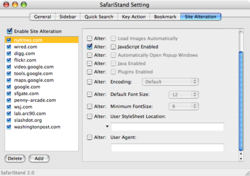tecznotes
Michal Migurski's notebook, listening post, and soapbox. Subscribe to ![]() this blog.
Check out the rest of my site as well.
this blog.
Check out the rest of my site as well.
Jun 5, 2006 6:17am
javascript redux
A week ago I vented my dislike for ajax abuse. I got a few comments about that, including one from Ray, who recommended Safari Stand as a possible answer. I'm here to say that it works really well.
It's a bit of a mystery application, apparently written by a Japanese developer as a sort of browser swiss army knife, adding all kinds of navigation features to Safari. I've come across it before, but have stayed away because I generally prefer lean software. I've been able to ignore all of its features, except for site alteration:
Each domain listed on the left can be modified to enable or disable certain site features, and impose new behaviors or stylesheets. I have most of these sites modified to kill javascript, and a few also have font-size adjustments. It's been a significant change for the better. The New York Times and Wired are both now usable, and I've also disabled scripts on other sites that seemed to be doing a bit too much client-sniffing or slowing down normal interactions. Even Flickr benefits: what I thought was server slowness for the past few months turns out to have been Ajax lag. Photo pages load significantly more quickly, and the only drawback has been the appearance of useless "For a better experience, please upgrade to a Javascript-capable browser" messages on NYT and Flickr. The reason there are a bunch of Google's in the list is that I'm shutting out all of *.google.com, and selectively allowing certain google.com subdomains that seem worthwhile. Stand reads the list from top to bottom, and the first match wins.
So far, I've been taking a black list approach. Sites that annoy me get the axe. If the list grows especially long, I may switch to a white list and allow Javascript only on certain domains. In the meantime, this is working very well.
